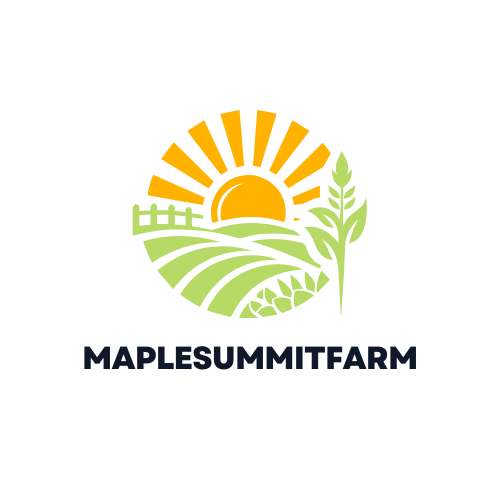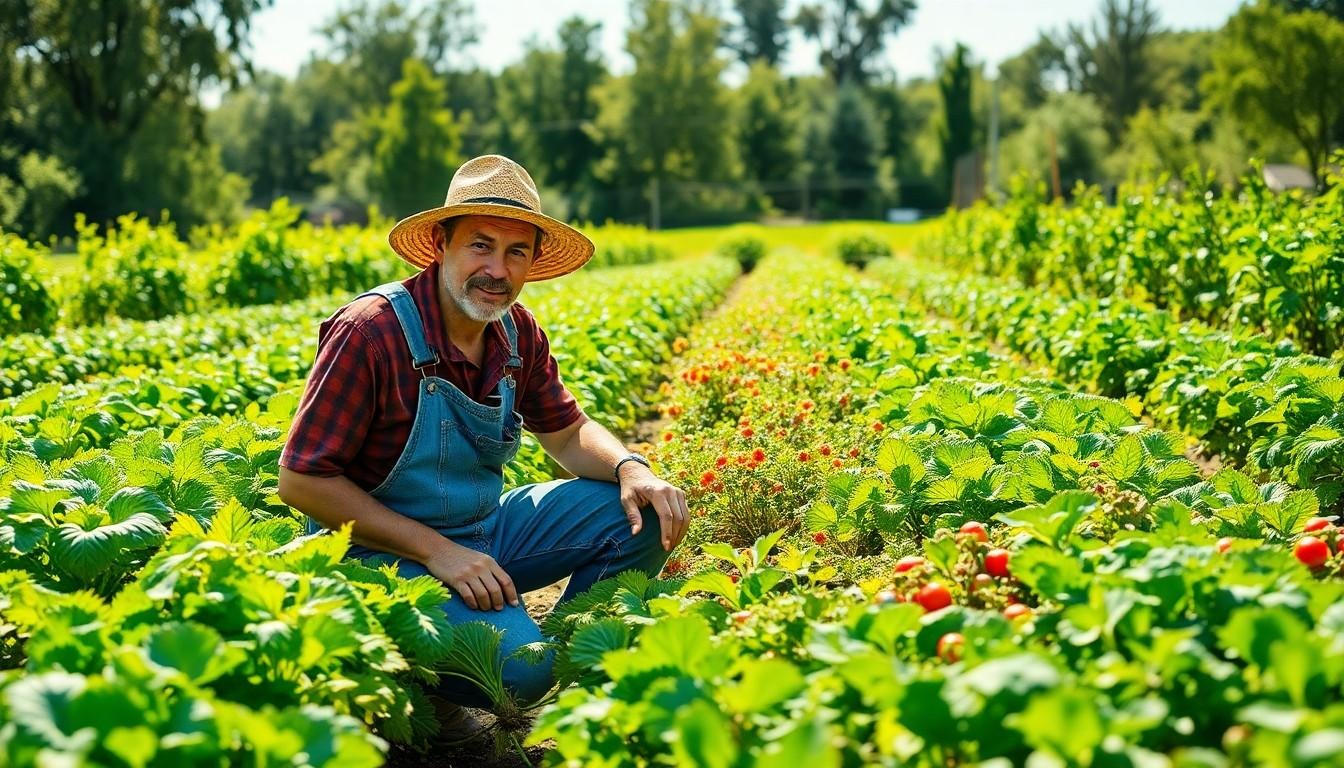In a world where fast food reigns supreme and plastic straws seem to multiply like rabbits, sustainable farming techniques are like the superheroes we didn’t know we needed. They swoop in to save our planet, one organic carrot at a time. Imagine a farm where crops grow without the help of chemical villains and livestock roam freely, living their best lives. Sounds dreamy, right?
Sustainable Farming Techniques
Sustainable farming techniques encompass diverse practices aimed at minimizing environmental impact while enhancing productivity. Crop rotation fosters soil health by varying the type of crop grown in each season. This practice reduces pest infestations and soil depletion, promoting biodiversity.
Agroforestry integrates trees and shrubs with crops or livestock systems. This method improves land productivity and offers additional income sources while enhancing soil quality and carbon sequestration. Controlled grazing practices manage livestock movement, allowing vegetative recovery and reducing overgrazing.
Conservation tillage minimizes soil disturbance, preserving organic matter and improving water retention. Farmers employing this technique often observe reduced erosion and enhanced soil structure. Organic farming relies heavily on natural inputs, eschewing synthetic pesticides and fertilizers to maintain ecological balance.
Cover cropping prevents soil erosion and enhances fertility by planting cover crops during off-seasons. Farmers benefit from improved soil health and reduced weed pressure by introducing these crops. Integrated pest management employs biological controls, minimizing chemical interventions and supporting ecological balance.
Hydroponics allows for soil-less farming, making efficient use of water and nutrients. This technique provides a controlled environment, often leading to faster growth rates and increased yields. Vertical farming utilizes vertical space for crop production, optimizing land usage in urban areas and reducing transportation emissions.
Utilizing renewable energy sources, such as solar or wind, is increasingly common among sustainable farms. These energy sources reduce reliance on fossil fuels, decreasing overall carbon footprints. Each sustainable technique promotes not only productivity but also environmental stewardship, addressing issues associated with modern agriculture.
Benefits of Sustainable Farming Techniques

Sustainable farming techniques offer significant benefits, enhancing both environmental health and economic viability. By implementing these practices, farmers contribute to a more sustainable future.
Environmental Impact
Sustainable farming minimizes negative effects on ecosystems. Practices such as crop rotation and agroforestry enhance soil health and biodiversity, leading to richer ecosystems. Controlled grazing improves vegetative recovery, reducing overgrazing and promoting habitat restoration. Conservation tillage preserves soil structure and decreases erosion, ensuring long-term soil viability. Cover cropping enhances fertility, preventing nutrient runoff and supporting water retention. Integrated pest management reduces chemical pesticide use, lowering risks to wildlife and water quality. Finally, renewable energy sources like solar power lessen dependence on fossil fuels, thus lowering carbon footprints.
Economic Advantages
Economic benefits accompany sustainable farming practices. Reduced input costs from organic farming methods lead to higher profit margins. Crop diversification minimizes market risks, providing farmers with stable income streams. Sustainable farms often qualify for grants and subsidies, supporting their transition to ecological practices. Increased consumer demand for locally-sourced organic products results in higher prices for sustainable goods. Additionally, sustainable practices attract eco-conscious consumers, enhancing marketability and brand loyalty. The adoption of innovative techniques, such as hydroponics and vertical farming, maximizes land efficiency, enabling greater crop yields in limited spaces.
Common Sustainable Farming Techniques
Sustainable farming techniques play a crucial role in promoting environmental health while ensuring productivity. Below are some key methods commonly employed.
Crop Rotation
Crop rotation involves alternating different crops in a specific sequence on the same land. This practice enhances soil health and reduces pest and disease buildup, benefiting both crop yield and biodiversity. Growing legumes, for example, enriches the soil with nitrogen, improving the nutrient profile for subsequent crops. By diversifying plant types, farmers disrupt pest cycles and minimize the reliance on chemical pesticides. Rotation also preserves soil structure and reduces erosion. Farmers can experience increased resilience against climate variability, contributing to long-term agricultural sustainability.
Agroforestry
Agroforestry integrates trees with crops or livestock, creating a multifunctional landscape. This technique boosts land productivity, mitigates soil erosion, and enhances biodiversity. Trees provide shade, improve microclimates, and supply organic matter when leaves decompose. Livestock benefit from forage availability while maintaining soil health through natural fertilization. Farmers who adopt agroforestry often experience improved water retention in soils and increased resilience against environmental extremes. Yield diversification and market opportunities for products like fruits and timber also arise, making agroforestry an economically viable option.
Organic Farming
Organic farming emphasizes natural inputs to maintain ecological balance and soil health. This method avoids synthetic pesticides and fertilizers, relying instead on compost, cover crops, and crop rotations to build fertile soils. Organic practices foster biodiversity, supporting a wide range of insects and wildlife. Techniques like polyculture and intercropping help maximize resource use and reduce weed competition. Certification as organic can lead to higher market prices and access to a growing consumer base that prioritizes sustainability. As organic farming becomes more popular, it also contributes to reducing the carbon footprint associated with conventional agriculture methods.
Challenges in Implementing Sustainable Farming Techniques
Sustainable farming techniques face several significant challenges that can hinder their adoption and effectiveness.
Financial Barriers
High initial investment costs often deter farmers from implementing sustainable practices. Equipment for organic farming and renewable energy systems can require considerable financial resources. Additionally, sustainable methods may lead to lower yields during the transition period, impacting immediate income. Limited access to credit sources exacerbates these issues, making it challenging for farmers to secure funding. Grants and subsidies are available, but navigating this financial landscape is complex. Many farmers remain unaware of the financial benefits associated with sustainable farming. Budgeting for long-term recovery can ultimately make these practices more viable.
Knowledge Gaps
Knowledge gaps present another major obstacle to sustainable farming. Many farmers lack access to information about sustainable techniques and practices. Training programs often focus on traditional methods, leaving farmers ill-equipped to adopt innovative practices. Local extension services may not offer adequate support, requiring farmers to rely on peers or online resources. This reliance can lead to inconsistencies in knowledge application. Those interested in implementing sustainable farming often lack formal education in soil health, pest management, and biodiversity. Bridging these knowledge gaps is crucial for promoting sustainability in agriculture.
Future of Sustainable Farming Techniques
Innovative technology continues to shape the future of sustainable farming techniques. Increased adoption of precision agriculture allows farmers to use data to optimize resource management, reducing waste and enhancing crop yields. Advanced sensors and drones enable real-time monitoring of soil health, pest activity, and water usage.
Diverse cropping systems gain popularity as farmers seek to improve resilience against climate change. These systems bolster biodiversity and enhance soil health while minimizing pest outbreaks. Improved crop rotation practices offer solutions for maintaining soil fertility and reducing disease pressure among plants.
The development of regenerative agriculture plays a significant role in the future landscape of farming. This holistic approach focuses on restoring soil health, capturing carbon, and enhancing water retention. Techniques such as cover cropping and reduced tillage contribute to these goals by promoting a thriving ecosystem.
Utilizing agroecological principles encourages farmers to mimic natural processes. This method involves integrating livestock into cropping systems, which naturally fertilizes the soil and reduces reliance on chemical inputs. Collaboration between farmers and researchers drives knowledge sharing and best practices for sustainable methods.
Renewable energy integration emerges as another crucial element in sustainable farming’s future. Solar panels and wind turbines help power farms, significantly lowering greenhouse gas emissions. As these technologies become more cost-effective, their adoption rates among farmers will likely increase.
Supporting policies and consumer preferences also drive the sustainable farming movement. Government programs that incentivize sustainable practices create financial support for farmers. Increased demand for organic products motivates farmers to transition away from conventional agriculture, fostering a thriving market for sustainable goods.
Investment in research and development ensures continued progress in sustainable agriculture techniques. Partnerships within the agricultural sector facilitate innovation, helping farmers meet the challenges posed by a changing environment.

